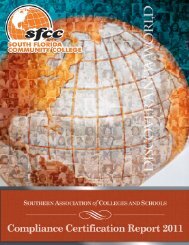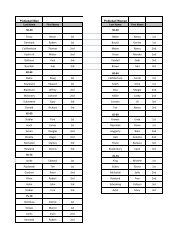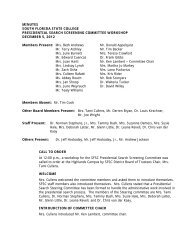2006-07 College Catalog - South Florida State College
2006-07 College Catalog - South Florida State College
2006-07 College Catalog - South Florida State College
- No tags were found...
Create successful ePaper yourself
Turn your PDF publications into a flip-book with our unique Google optimized e-Paper software.
5HWXUQWR6HFWLRQ0HQXFLORIDA’S STATEWIDE COURSENUMBERING SYSTEMCourses in this <strong>Catalog</strong> are identified by prefixes and numbers that were assigned by <strong>Florida</strong>’s <strong>State</strong>wide Course NumberingSystem. This numbering system is used by all public postsecondary institutions in <strong>Florida</strong> and 33 participating non-publicinstitutions. The major purpose of this system is to facilitate the transfer of courses between participating institutions.Each participating institution controls the title, credit, and content of its own courses and recommends the first digit of thecourse number to indicate the level at which students normally take the course. Course prefixes and the last three digits of thecourse numbers are assigned by members of faculty discipline committees appointed for that purpose by the <strong>Florida</strong> Departmentof Education in Tallahassee. Individuals nominated to serve on these committees are selected to maintain a representativebalance as to type of institution and discipline field or specialization.The course prefix and each digit in the course number have a meaning in the <strong>State</strong>wide Course Numbering System (SCNS).The list of course prefixes and numbers, along with their generic titles, is referred to as the “SCNS taxonomy.” Descriptions ofthe content of courses are referred to as “course equivalency profiles.”EXAMPLE OF COURSE IDENTIFIERPrefix Level Code Century Digit Decade Digit Unit Digit Lab Code(first digit) (second digit) (third digit) (fourth digit)SYG 2 0 0 0GeneralSociologySophomoreLevel at thisinstitutionEntry-LevelGeneralSociologySurvey Course SocialProblemsNolaboratorycomponentin thiscourseGENERAL RULE FOR COURSE EQUIVALENCIESEquivalent courses at different institutions are identified by the same prefixes and same last three digits of the course numberand are guaranteed to be transferable between participating institutions that offer the course, with a few exceptions. (Exceptionsare listed below.)For example, a survey course in social problems is offered by 35 different postsecondary institutions. Each institution uses“SYG_000” to identify its social problems course. The level code is the first digit and represents the year in which studentsnormally take the course at a specific institution. In the SCNS taxonomy, “SYG” means “Sociology, General,” the century digit “0”represents “Entry-level General Sociology,” the decade digit “0” represents “Survey Course,” and the unit digit “0” represents“Social Problems.”In science and other areas, a “C” or “L” after the course number is known as a lab indicator. The “C” represents a combinedlecture and laboratory course that meets in the same place at the same time. The “L” represents a laboratory course or thelaboratory part of a course, having the same prefix and course number without a lab indicator, which meets at a different timeor place.Transfer of any successfully completed course from one institution to another is guaranteed in cases where the course to betransferred is equivalent to one offered by the receiving institution. Equivalencies are established by the same prefix and lastthree digits and comparable faculty credentials at both institutions. For example, SYG 2000 is offered at a community college.The same course is offered at a state university as SYG 2010. A student who has successfully complete SYG 2000 at thecommunity college is guaranteed to receive transfer credit for SYG 2010 at the state university if the student transfers. Thestudent cannot be required to take SYG 2010 again since SYG 2000 is equivalent to SYG 2010. Transfer credit must beawarded for successfully completed equivalent courses and used by the receiving institution to determine satisfaction ofrequirements by transfer students on the same basis as credit awarded to the native students. It is the prerogative of thereceiving institution, however, to offer transfer credit for courses successfully completed which have not been designated asequivalent.142
















